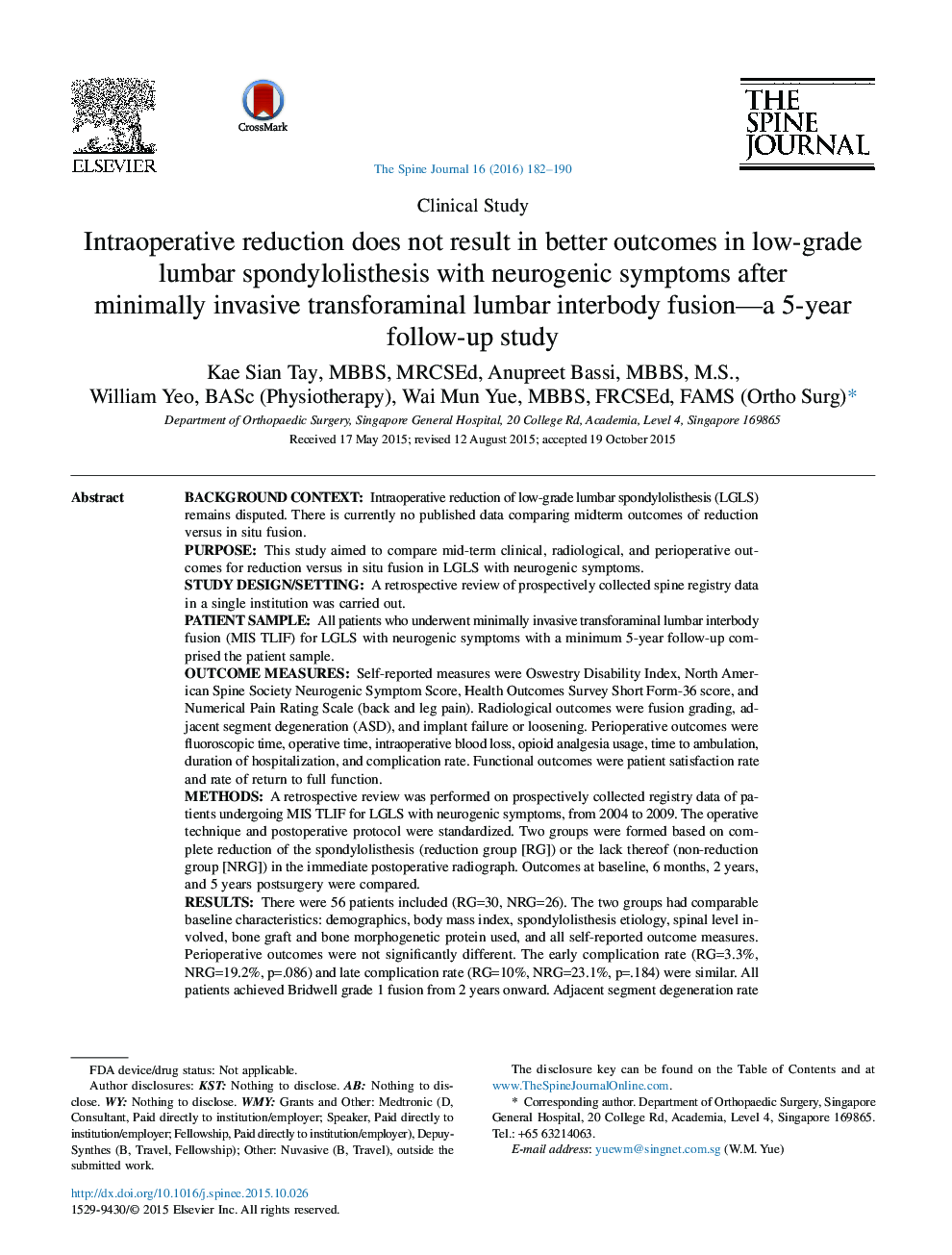| کد مقاله | کد نشریه | سال انتشار | مقاله انگلیسی | نسخه تمام متن |
|---|---|---|---|---|
| 6211608 | 1268554 | 2016 | 9 صفحه PDF | دانلود رایگان |
Background ContextIntraoperative reduction of low-grade lumbar spondylolisthesis (LGLS) remains disputed. There is currently no published data comparing midterm outcomes of reduction versus in situ fusion.PurposeThis study aimed to compare mid-term clinical, radiological, and perioperative outcomes for reduction versus in situ fusion in LGLS with neurogenic symptoms.Study Design/SettingA retrospective review of prospectively collected spine registry data in a single institution was carried out.Patient SampleAll patients who underwent minimally invasive transforaminal lumbar interbody fusion (MIS TLIF) for LGLS with neurogenic symptoms with a minimum 5-year follow-up comprised the patient sample.Outcome MeasuresSelf-reported measures were Oswestry Disability Index, North American Spine Society Neurogenic Symptom Score, Health Outcomes Survey Short Form-36 score, and Numerical Pain Rating Scale (back and leg pain). Radiological outcomes were fusion grading, adjacent segment degeneration (ASD), and implant failure or loosening. Perioperative outcomes were fluoroscopic time, operative time, intraoperative blood loss, opioid analgesia usage, time to ambulation, duration of hospitalization, and complication rate. Functional outcomes were patient satisfaction rate and rate of return to full function.MethodsA retrospective review was performed on prospectively collected registry data of patients undergoing MIS TLIF for LGLS with neurogenic symptoms, from 2004 to 2009. The operative technique and postoperative protocol were standardized. Two groups were formed based on complete reduction of the spondylolisthesis (reduction group [RG]) or the lack thereof (non-reduction group [NRG]) in the immediate postoperative radiograph. Outcomes at baseline, 6 months, 2 years, and 5 years postsurgery were compared.ResultsThere were 56 patients included (RG=30, NRG=26). The two groups had comparable baseline characteristics: demographics, body mass index, spondylolisthesis etiology, spinal level involved, bone graft and bone morphogenetic protein used, and all self-reported outcome measures. Perioperative outcomes were not significantly different. The early complication rate (RG=3.3%, NRG=19.2%, p=.086) and late complication rate (RG=10%, NRG=23.1%, p=.184) were similar. All patients achieved Bridwell grade 1 fusion from 2 years onward. Adjacent segment degeneration rate at 5 years was similar (RG=10%, NRG=0%, p=NS). Both groups showed significant postoperative improvement in all self-reported measures with no significant differences between the two groups at all follow-up points. Functional outcomes were equivalent.ConclusionsIntraoperative reduction does not improve outcomes in LGLS with neurogenic symptoms after MIS TLIF. Adequate decompression and solid fusion are likely the keys to good mid-term outcomes.
Journal: The Spine Journal - Volume 16, Issue 2, February 2016, Pages 182-190
